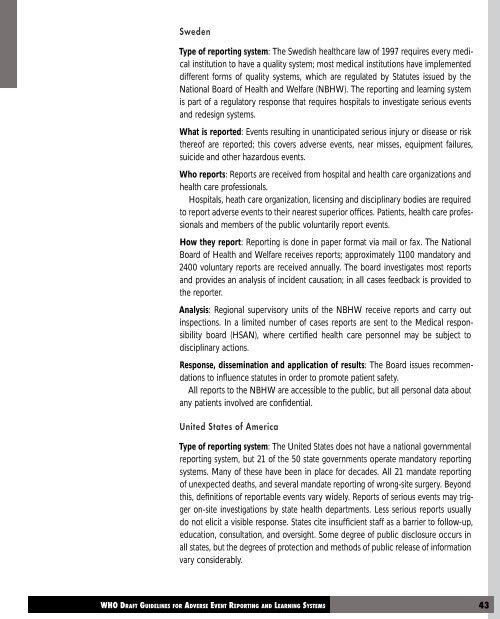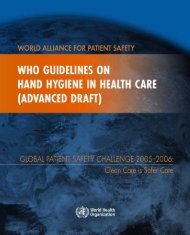Adverse event reporting.pdf
Adverse event reporting.pdf
Adverse event reporting.pdf
Create successful ePaper yourself
Turn your PDF publications into a flip-book with our unique Google optimized e-Paper software.
Sweden<br />
Type of <strong>reporting</strong> system: The Swedish healthcare law of 1997 requires every medical<br />
institution to have a quality system; most medical institutions have implemented<br />
different forms of quality systems, which are regulated by Statutes issued by the<br />
National Board of Health and Welfare (NBHW). The <strong>reporting</strong> and learning system<br />
is part of a regulatory response that requires hospitals to investigate serious <strong>event</strong>s<br />
and redesign systems.<br />
What is reported: Events resulting in unanticipated serious injury or disease or risk<br />
thereof are reported; this covers adverse <strong>event</strong>s, near misses, equipment failures,<br />
suicide and other hazardous <strong>event</strong>s.<br />
Who reports: Reports are received from hospital and health care organizations and<br />
health care professionals.<br />
Hospitals, heath care organization, licensing and disciplinary bodies are required<br />
to report adverse <strong>event</strong>s to their nearest superior offices. Patients, health care professionals<br />
and members of the public voluntarily report <strong>event</strong>s.<br />
How they report: Reporting is done in paper format via mail or fax. The National<br />
Board of Health and Welfare receives reports; approximately 1100 mandatory and<br />
2400 voluntary reports are received annually. The board investigates most reports<br />
and provides an analysis of incident causation; in all cases feedback is provided to<br />
the reporter.<br />
Analysis: Regional supervisory units of the NBHW receive reports and carry out<br />
inspections. In a limited number of cases reports are sent to the Medical responsibility<br />
board (HSAN), where certified health care personnel may be subject to<br />
disciplinary actions.<br />
Response, dissemination and application of results: The Board issues recommendations<br />
to influence statutes in order to promote patient safety.<br />
All reports to the NBHW are accessible to the public, but all personal data about<br />
any patients involved are confidential.<br />
United States of America<br />
Type of <strong>reporting</strong> system: The United States does not have a national governmental<br />
<strong>reporting</strong> system, but 21 of the 50 state governments operate mandatory <strong>reporting</strong><br />
systems. Many of these have been in place for decades. All 21 mandate <strong>reporting</strong><br />
of unexpected deaths, and several mandate <strong>reporting</strong> of wrong-site surgery. Beyond<br />
this, definitions of reportable <strong>event</strong>s vary widely. Reports of serious <strong>event</strong>s may trigger<br />
on-site investigations by state health departments. Less serious reports usually<br />
do not elicit a visible response. States cite insufficient staff as a barrier to follow-up,<br />
education, consultation, and oversight. Some degree of public disclosure occurs in<br />
all states, but the degrees of protection and methods of public release of information<br />
vary considerably.
















